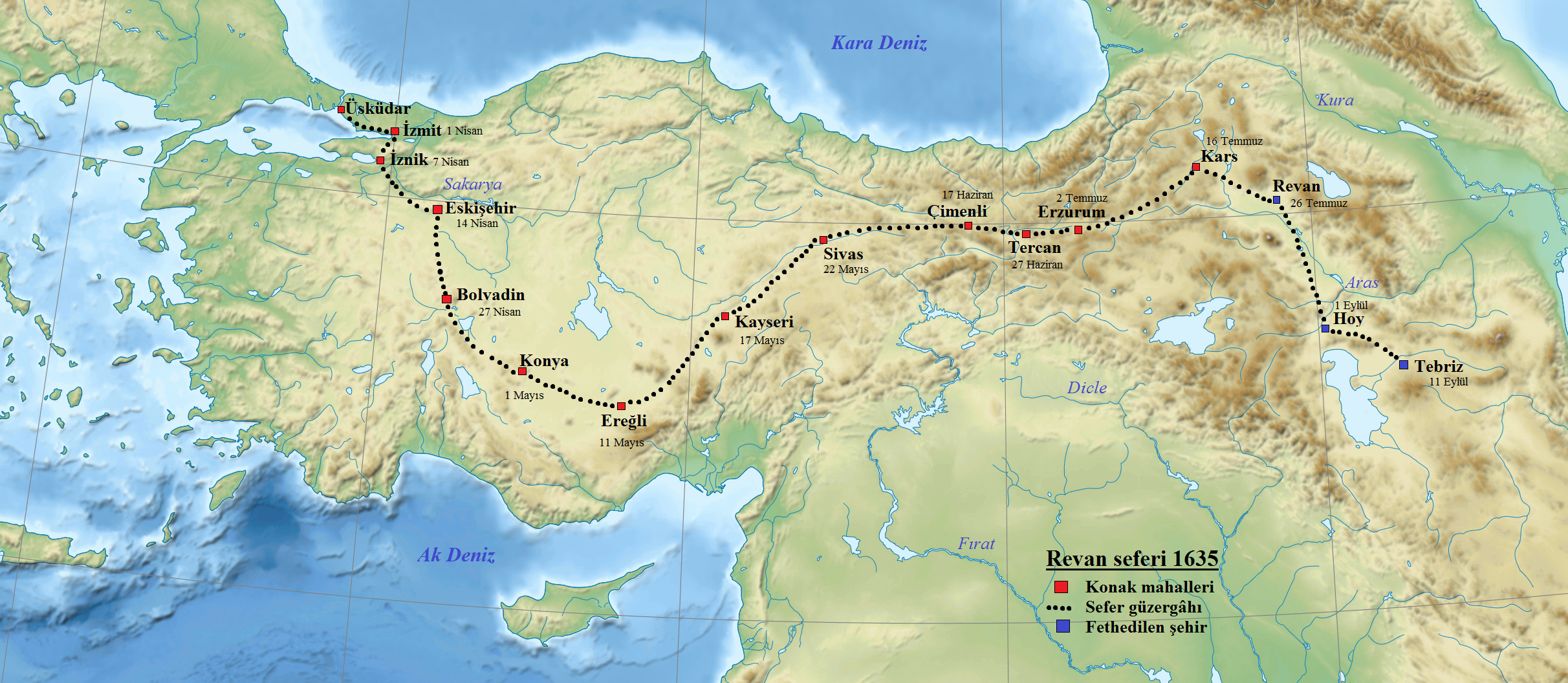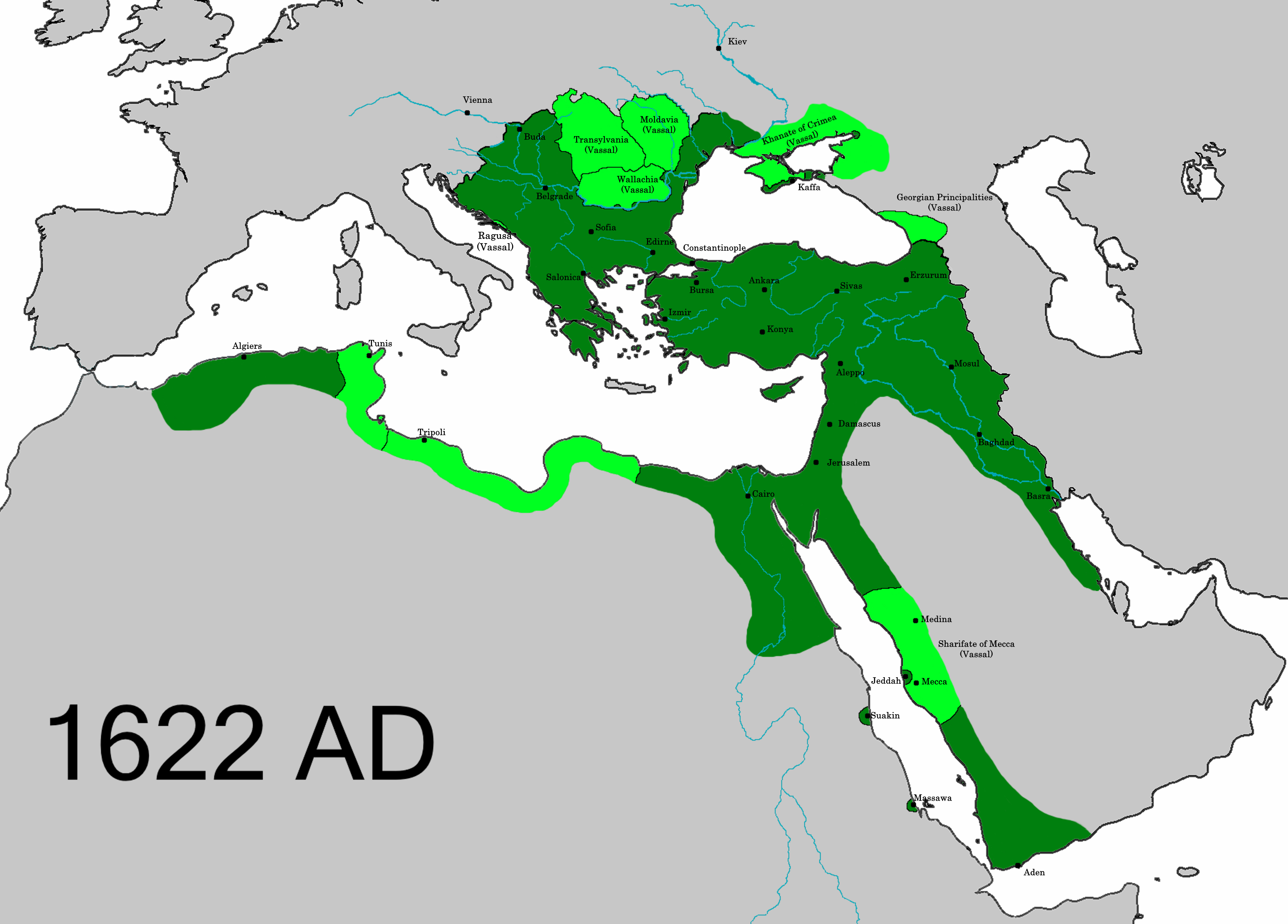|
Åehzade SÞleyman
Åehzade SÞleyman ( Ottoman Turkish: ØīŲØēاØŊŲ ØģŲŲŲ اŲ; 1613 â 27 July 1635) was an Ottoman prince and the son of Sultan Ahmed I and his wife KÃķsem Sultan. He was the brother of Murad IV and Ibrahim, and half-brother of Osman II. Life Åehzade SÞleyman was born in 1614 in TopkapÄą Palace to Ahmed I and (very probraly) KÃķsem Sultan. Following his father's early death in 1617, he and his siblings were exiled to the Old Palace (Eski Saray). After Muradâs accession in 1623, SÞleyman was confined in the Kafes. Death In 1635, SÞleyman, his (maybe) brother Selim and his half-brother Bayezid were executed during the celebrations over the victory at Erivan. The orders were carried out by Murad IV, the cause of SÞleymanâs execution is unknown. It was most likely that he was found favored on the throne by Murad Murad or Mourad ( ar, Ų ØąØ§ØŊ) is an Arabic name. It is also common in Armenian, Azerbaijani, Bengali, Turkish, Persian, and Berber as a male given ... [...More Info...] [...Related Items...] OR: [Wikipedia] [Google] [Baidu] |
Blue Mosque, Istanbul
The Blue Mosque in Istanbul, also known by its official name, the Sultan Ahmed Mosque ( tr, Sultan Ahmet Camii), is an Ottoman-era historical imperial mosque located in Istanbul, Turkey. A functioning mosque, it also attracts large numbers of tourist visitors. It was constructed between 1609 and 1616 during the rule of Ahmed I. Its KÞlliye contains Ahmed's tomb, a madrasah and a hospice. Hand-painted blue tiles adorn the mosqueâs interior walls, and at night the mosque is bathed in blue as lights frame the mosqueâs five main domes, six minarets and eight secondary domes. It sits next to the Hagia Sophia, the principal mosque of Istanbul until the Blue Mosque's construction and another popular tourist site. The Blue Mosque was included in the UNESCO World Heritage Site list in 1985 under the name of "Historic Areas of Istanbul". History After the Peace of Zsitvatorok and the crushing loss in the 1603â18 war with Persia, Sultan Ahmed I decided to build a large mosque i ... [...More Info...] [...Related Items...] OR: [Wikipedia] [Google] [Baidu] |
Ibrahim Of The Ottoman Empire
Ibrahim (; ota, اØĻØąØ§ŲŲŲ ; tr, Ä°brahim; 5 November 1615 â 18 August 1648) was the Sultan of the Ottoman Empire from 1640 until 1648. He was born in Constantinople, the son of Sultan Ahmed I by KÃķsem Sultan, an ethnic Greek originally named Anastasia. He was called Ibrahim the Mad ( tr, Deli Ä°brahim) due to his mental condition and behavior. However, historian Scott Rank notes that his opponents spread rumors of the sultan's insanity, and some historians suggest he was more incompetent than mad. Early life Ibrahim was born on 5 November 1615, the son of Sultan Ahmed I and his Haseki Sultan and perphaps legal wife, KÃķsem Sultan. When Ibrahim was 2, his father suddenly died, and Ibrahim's uncle Mustafa I became the new sultan. By that time, Kosem Sultan and her children, including young Ibrahim had been sent to the Old Palace. After the succession of his brother Murad IV, Ibrahim was confined in the Kafes, which affected his health. Ibrahim's other brothers Åehzade B ... [...More Info...] [...Related Items...] OR: [Wikipedia] [Google] [Baidu] |
Ottoman Princes
Ottoman is the Turkish spelling of the Arabic masculine given name Uthman ( ar, ØđŲØŦŲŲ اŲ, âuthmÄn). It may refer to: Governments and dynasties * Ottoman Caliphate, an Islamic caliphate from 1517 to 1924 * Ottoman Empire, in existence from 1299 to 1922 ** Ottoman dynasty, ruling family of the Ottoman Empire *** OsmanoÄlu family, modern members of the family * Ottoman architecture Ethnicities and languages * Ottoman Armenians, the Armenian ethnic group in the Ottoman Empire * Ottoman Greeks, the Greek ethnic group in the Ottoman Empire * Ottoman Serbs, the Serbian ethnic group in the Ottoman Empire * Ottoman Turks, the Turkic ethnic group in the Ottoman Empire ** Ottoman Turkish alphabet ** Ottoman Turkish language, the variety of the Turkish language that was used in the Ottoman Empire Products * Ottoman bed, a type of storage bed * Ottoman (furniture), padded stool or footstool * Ottoman (textile), fabric with a pronounced ribbed or corded effect, often made of silk or ... [...More Info...] [...Related Items...] OR: [Wikipedia] [Google] [Baidu] |
17th-century Ottoman Royalty
The 17th century lasted from January 1, 1601 ( MDCI), to December 31, 1700 ( MDCC). It falls into the early modern period of Europe and in that continent (whose impact on the world was increasing) was characterized by the Baroque cultural movement, the latter part of the Spanish Golden Age, the Dutch Golden Age, the French '' Grand SiÃĻcle'' dominated by Louis XIV, the Scientific Revolution, the world's first public company and megacorporation known as the Dutch East India Company, and according to some historians, the General Crisis. From the mid-17th century, European politics were increasingly dominated by the Kingdom of France of Louis XIV, where royal power was solidified domestically in the civil war of the Fronde. The semi-feudal territorial French nobility was weakened and subjugated to the power of an absolute monarchy through the reinvention of the Palace of Versailles from a hunting lodge to a gilded prison, in which a greatly expanded royal court could be mo ... [...More Info...] [...Related Items...] OR: [Wikipedia] [Google] [Baidu] |
OttomanâSafavid War (1623â1639)
The OttomanâSafavid War of 1623â1639 was the last of a series of conflicts fought between the Ottoman Empire and Safavid Empire, then the two major powers of Western Asia, over control of Mesopotamia. After initial Persian success in recapturing Baghdad and most of modern Iraq, having lost it for 90 years, the war became a stalemate as the Persians were unable to press further into the Ottoman Empire, and the Ottomans themselves were distracted by wars in Europe and weakened by internal turmoil. Eventually, the Ottomans were able to recover Baghdad, taking heavy losses in the final siege, and the signing of the Treaty of Zuhab ended the war in an Ottoman victory. Roughly speaking, the treaty restored the borders of 1555, with the Safavids keeping Dagestan, eastern Georgia, Eastern Armenia, and the present-day Azerbaijan Republic, while western Georgia and Western Armenia decisively came under Ottoman rule. The eastern part of Samtskhe (Meskheti) was irrevocably lost to the ... [...More Info...] [...Related Items...] OR: [Wikipedia] [Google] [Baidu] |
Åehzade Bayezid (son Of Ahmed I)
Åehzade Bayezid was an Ottoman prince, the fourth son of Sultan Ahmed I. Life He was born to Ahmed I and Gulbahar Sultan. He was a few months younger than his half-brother Åehzade Murad (future sultan Murad IV). When Ahmed died on 22 November 1617, he was placed in the Kafes with his half brothers Mehmed, Murad, Suleiman, Kasim and Ibrahim in unknown period during the reign of his uncle sultan Mustafa I and possible brother Osman II. After Mustafa was deposed and replaced by Osman, his half-brother Mehmed was exceuted under the orders of Osman one year before being Osman was murdered by his enemies that brought Mustafa once again in the throne. After Mustafa was deposed for a second time, Bayezid's half-brother Murad was placed in the throne before him due to been older a few months. However, on 27 July 1635, he was executed along his brother Åehzade Suleiman. The orders were carried out by Murad, the causes of his executions were unknown. It was most likely that he was found ... [...More Info...] [...Related Items...] OR: [Wikipedia] [Google] [Baidu] |
Kafes
The Kafes ( ota, ŲŲØģ, kafes, from ), literally "cage", was the part of the Imperial Harem of the Ottoman Palace where possible successors to the throne were kept under a form of house-arrest and constant surveillance by the palace guards. The early history of the Ottoman Empire is littered with succession wars between rival sons of the deceased sultan. It was common for a new sultan to have his brothers killed, including infants,{{cite book , last=Meyer , first=G. J. , author-link=G. J. Meyer , date=May 30, 2006 , title=A World Undone: The Story of the Great War, 1914 to 1918 , publisher=Delacorte Press , page=89 , isbn=0553803549 sometimes dozens of them at once. This practice reduced the number of claimants to the throne, leading to several occasions where the Ottoman line seemed destined to end. The confinement of heirs provided security for an incumbent sultan and continuity of the dynasty. First use When Ahmed I died in 1617, his eldest son was only 13 years old, and ... [...More Info...] [...Related Items...] OR: [Wikipedia] [Google] [Baidu] |
Eski Saray
Eski Saray ( Turkish for "Old Palace"), also known as SarÃĒy-Äą AtÃŪk-i Ãmire, was a palatial building in Constantinople during the period of Ottoman rule, and it was the first such palace built in the city following the conquest of 1453. It was located in the BeyazÄąt neighborhood of the Fatih district, in an area now housing the main campus of Istanbul University, between the SÞleymaniye Mosque and the Bayezid II Mosque. Construction of the palace commenced shortly after the 1453 conquest, and it was completed in 1458. Although historians of the period such as Doukas and Michael Critobulus stated that it was completed in 1455, the general opinion is that by then various parts such as the harem and mansion were finished, but it was not fully completed until 1458. Evliya Ãelebi stated in his ''SeyahatnÃĒme'' that the construction of the palace began in 1454 on the site of an old church and that the palace was surrounded by a solid rectangular wall covered with a blue lead tha ... [...More Info...] [...Related Items...] OR: [Wikipedia] [Google] [Baidu] |
Osman II
Osman II ( ota, ØđØŦŲ اŲ ØŦاŲŲ ''âOsmÄn-i sÄnÄŦ''; tr, II. Osman; 3 November 1604 â 20 May 1622), also known as Osman the Young ( tr, Genç Osman), was Sultan of the Ottoman Empire from 26 February 1618 until his regicide on 20 May 1622. Early life Osman II was born at TopkapÄą Palace, Constantinople, the son of Sultan Ahmed I (1603–17) and one of his consorts Mahfiruz Hatun. According to later traditions, at a young age, his mother had paid a great deal of attention to Osman's education, as a result of which Osman II became a known poet and was believed to have mastered many languages, including Arabic, Persian, Greek, Latin, and Italian; although this has since been refuted. Osman was born eleven months after his father Ahmed's transition to the throne. He was trained in the palace. According to foreign observers, he was one of the most cultured of Ottoman princes. Osman's failure to capture the throne at the death of his father Ahmed might have been cau ... [...More Info...] [...Related Items...] OR: [Wikipedia] [Google] [Baidu] |
Murad IV
Murad IV ( ota, Ų ØąØ§ØŊ ØąØ§ØĻØđ, ''MurÄd-Äą RÄbiĘŋ''; tr, IV. Murad, was the Sultan of the Ottoman Empire from 1623 to 1640, known both for restoring the authority of the state and for the brutality of his methods. Murad IV was born in Constantinople, the son of Sultan Ahmed I (r. 1603â17) and KÃķsem Sultan. He was brought to power by a palace conspiracy when he was just 11 years old, and he succeeded his uncle Mustafa I (r. 1617â18, 1622â23). Until he assumed absolute power on 18 May 1632, the empire was ruled by his mother, KÃķsem Sultan, as ''nÄĘūib-i saláđanat'' (regent). His reign is most notable for the OttomanâSafavid War, of which the outcome would partition the Caucasus between the two Imperial powers for around two centuries, while it also roughly laid the foundation for the current TurkeyâIranâIraq borders. Early life Murad IV was born on 27 July 1612 to Ahmed I (reign 16031617) and his consort and later wife KÃķsem Sultan, an ethnic Greek. Af ... [...More Info...] [...Related Items...] OR: [Wikipedia] [Google] [Baidu] |
Istanbul
Istanbul ( , ; tr, Ä°stanbul ), formerly known as Constantinople ( grc-gre, ÎÏÎ―ÏÏÎąÎ―ÏÎđÎ―ÎŋÏÏÎŋÎŧÎđÏ; la, Constantinopolis), is the List of largest cities and towns in Turkey, largest city in Turkey, serving as the country's economic, cultural and historic hub. The city straddles the Bosporus strait, lying in both Europe and Asia, and has a population of over 15 million residents, comprising 19% of the population of Turkey. Istanbul is the list of European cities by population within city limits, most populous European city, and the world's List of largest cities, 15th-largest city. The city was founded as Byzantium ( grc-gre, ÎÏ ÎķÎŽÎ―ÏÎđÎŋÎ―, ) in the 7th century BCE by Ancient Greece, Greek settlers from Megara. In 330 CE, the Roman emperor Constantine the Great made it his imperial capital, renaming it first as New Rome ( grc-gre, ÎÎÎą áŋŽÏΞη, ; la, Nova Roma) and then as Constantinople () after himself. The city grew in size and influence, eventually becom ... [...More Info...] [...Related Items...] OR: [Wikipedia] [Google] [Baidu] |
Ottoman Turkish Language
Ottoman Turkish ( ota, ŲŲØģاŲŲ ØđŲØŦŲ اŲŲ, LisÃĒn-Äą OsmÃĒnÃŪ, ; tr, OsmanlÄą TÞrkçesi) was the standardized register of the Turkish language used by the citizens of the Ottoman Empire (14th to 20th centuries CE). It borrowed extensively, in all aspects, from Arabic and Persian, and its speakers used the Ottoman Turkish alphabet for written communication. During the peak of Ottoman power (), words of foreign origin in Turkish literature in the Ottoman Empire heavily outnumbered native Turkish words, with Arabic and Persian vocabulary accounting for up to 88% of the Ottoman vocabulary in some texts.''Persian Historiography & Geography''Pustaka Nasional Pte Ltd p 69 Consequently, Ottoman Turkish was largely unintelligible to the less-educated lower-class and to rural Turks, who continued to use ("raw/vulgar Turkish"; compare Vulgar Latin and Demotic Greek), which used far fewer foreign loanwords and is the basis of the modern standard. The TanzimÃĒt era (1839â187 ... [...More Info...] [...Related Items...] OR: [Wikipedia] [Google] [Baidu] |
.jpg)





